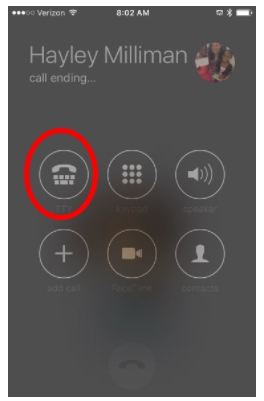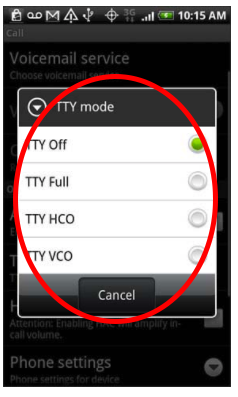
A TTY (teletypewriter) is a device that helps people who are deaf, speech-impaired, or hard-of-hearing use a phone to communicate. While TTY devices were initially designed for landline phones, they are used today with both landlines and cell phones.
In this article, I’ll be talking about TTY mode meaning on a cell phone and how to use it, as well as offering other, more modern options for people with hearing or speech impairments to communicate.
What Is TTY Mode on a Cell Phone?
A TTY device is used to communicate by people with speech and hearing impairments. A user with a speech impairment can type a message on the TTY machine and the machine will send the message through a phone line or mobile signal. For users with hearing impairments, the TTY machine will turn voice messages into text messages so the user can read them.
While a TTY machine may sound a lot like text messaging, its actual functions are more seamless. TTY machines allow users to continuously communicate as part of one conversation, without receiving constant message notifications and updates like from text messages. During a TTY conversation, the messages appear immediately on the other party’s TTY screen without interruption. TTY devices can be connected to both landlines and cell phones, allowing for portable communication.
Today, many cell phones have a TTY mode. What's the TTY mode meaning? Well, TTY mode allows the phone to function as a TTY device. Depending on the phone, it may have a built-in TTY software, allow you to connect the phone to an external TTY device, or both.
Many phones have three different TTY modes: TTY Full, TTY VCO, and TTY HCO. TTY Full mode allows both the sender and receiver to communicate through TTY messages. TTY VCO mode is for hearing-impaired users who can send messages through voice, but need to receive messages on a TTY text display. TTY HCO mode is for users who can receive voice messages, but need to send text messages.
How to Use TTY Mode on a Cell Phone
You can activate TTY mode on both an Android phone and an iPhone. In this section, I’ll talk you through how to use TTY mode on both operating systems.
How to Use TTY Mode on an iPhone

- Tap the “Settings” app.
- Tap “General” from the “Settings” menu.
- Tap “Accessibility” from the “General” menu.
- Select “TTY”.
- Select if you will use the built-in “Software TTY” or if you will attach an external device through “Hardware TTY.”
- Exit to the home screen.
- Select “Phone.”
- Select the person you want to call.
- When the call screen opens, tap the “TTY” button.
- Type the message you’d like to send to begin the call.
If you’ve turned TTY mode on an iPhone on, you can make a call with or without the TTY mode. You can also return to the settings menu to turn TTY mode off if you no longer need it.
How to Use TTY Mode on an Android Phone

- Select the “Applications” tab.
- Select the “Settings” application.
- Select “Call” from the “Settings” application.
- Select “TTY mode” from the “Call” menu.
- Select the desired TTY mode (TTY Off, TTY Full, TTY HCO, TTY VCO, which are three different types of TTY I discussed in the previous section).
- Tap back to the main menu to make a call. You can now select whether you want to make the call normally, or using the selected TTY mode.
To turn TTY mode off, you simply follow the same steps and select “TTY off” from the TTY mode menu.
Alternative Options for Communication for People With Speech or Hearing Impairments
Today, physical TTY devices are fairly out-dated. Most people use TTY mode on their cell phones, or communicate through one of these alternative means.
Text Messaging
For people with speech and hearing impairments, text messaging has become one of the easiest and most effective means of communication. Text messaging is easy, built-in to every cell phone, and most tablets, and computers, and doesn’t require any extra set up.
Video Calls
The rise in video calling technology like Facetime, Google Hangouts, and Skype has made it easier for people with speech and hearing impairments to communicate using sign language. Today, people with these disabilities can use video conferencing technology to talk in real-time with their friends and loved ones using sign language that both parties can see.
Video Relay Services
Video Relay Service is a form of Telecommunications Relay Service that enables persons with hearing disabilities who use American Sign Language to communicate with voice telephone users through video equipment, rather than through typed text. Video equipment links the VRS user with a TRS operator (Called a communications assistant, or CA) so that the VRS user and the CA can see and communicate with each other in signed conversation.
Because the conversation between the VRS user and the CA flows much more quickly than with a text-based TRS call, VRS has become an enormously popular form of TRS.
Recap: Using TTY Mode on a Cell Phone
What is TTY mode on a cell phone? TTY mode allows people with hearing and speech impairments to communicate by using text-to-voice or voice-to-text technology. Today, most cell phones are equipped with built-in TTY technology meaning that you don’t have to purchase an additional TTY device to communicate. There are also numerous other methods of communication for people with speech and hearing impairments, including text messaging, video calls, and video relay services.










